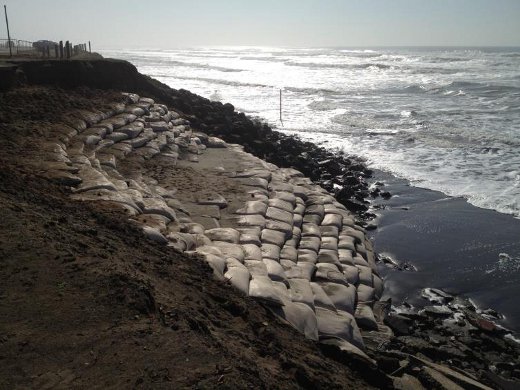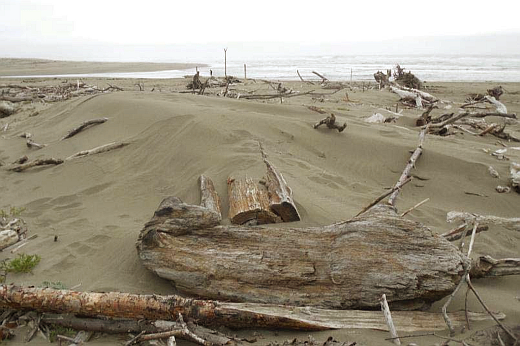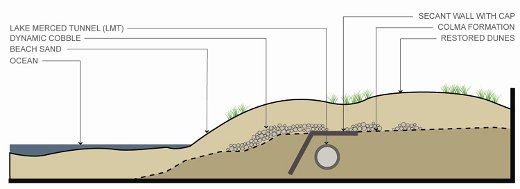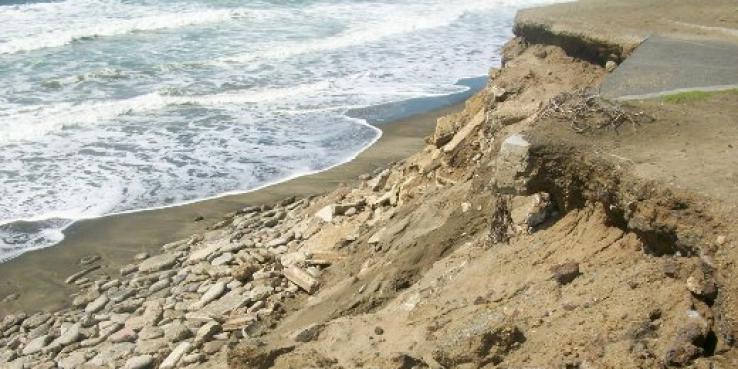What is the Coastal Management Framework?
SPUR, our coastal engineering consulting team and partner agencies are working together to develop a Coastal Management Framework (CMF). This implementation study, funded by San Francisco Public Utilities Commission, will define a series of projects to protect Ocean Beach and threatened infrastructure from the dual pressures of extreme weather events and sea level rise in an adaptive and responsive manner. Based on the Ocean Beach Master Plan (OBMP) recommendations, it will delineate coastal protection action plans for three different time spans: an immediate-term (1-3 years), an interim (3-10 years) and a long-term (10-40 years).
Immediate - Term Coastal Erosion Management Plan
While the long-term strategies of the CMF are developed, Ocean Beach still faces the potential threat of a severe storm that could exacerbate current erosion issues, particularly at the “hot spot” at the south end of South Ocean Beach. The Immediate-Term Management plan covers the first three storm seasons and identifies a package of softer coastal management tools that have proven successful in recent efforts to address erosion. Proposed interventions include the combination of sand placement between the high tide line and the eroding beach bluffs with sandbag structures that can be filled in advance nearby and deployed rapidly. Another measure under consideration is to consolidate concrete rubble that is currently on the beach into an erosion-resistant slope, protecting the bluff toe and getting it off the beach. These recommendations can be implemented incrementally, are reversible in nature, have limited environmental impact and serve multiple objectives, consistent with the OBMP.

The Immediate Coastal Management Plan recommends the continuation of sandbag placement based on observations of its current satisfactory performance. Image of sandbag placement on Ocean Beach by Damien Kunz, ESA PWA (February 2012).
Ocean Beach Wind Blown Sand Management
The 2012 Sand Backpassing Project proved to be an effective measure against erosion and a successful interagency partnership. However, it came with some unintended consequences. Dr. Peter Baye and coastal engineers from ESA PWA and Moffatt & Nichol Engineers have identified a series of sand stabilizing techniques to address the issue of wind-blown sand that is transported onto the bluff-top parking and roadways. These measures can help SPUR, the National Park Service and the City and County of San Francisco in implementing future beach nourishment projects. Driftwood jams and placement of shell fragments or coarser sands can trap the sand in place and limit its transfer while blending harmoniously within the beach environment. Together with information signs, they can also direct beachgoers toward limited access points.These practices minimize recreational and aesthetic nuisances and maintain public beach access. Demonstration projects of windblown sand management techniques will be developed and incorporated into future sand placement projects.

Driftwood jams on the beach can function as a sand trap with a natural feel. Image courtesy of Peter Baye.
Vulnerability Analysis and Coastal Engineering Feasibility Study
The consulting team is also developing a vulnerability and coastal engineering feasibility study to determine the most appropriate long-term strategies and actions for Ocean Beach. The vulnerability assessment indicates limited vulnerability in the immediate term but widespread vulnerability in coming decades. New findings support the OBMP vision of replacing current revetments with a low profile structure combined with managed retreat and realignment. Various structural alternatives that can provide bluff support and adequate protection to the critical infrastructure of Lake Merced Tunnel (LMT) are possible. Options like a jet grout or secant pile structure show particular promise since they can be implemented from the top without disrupting the bluff. These measures can allow for bluff restoration, beach cleanup, improved access, and various recreational opportunities. The team will perform additional modelling and collect supplementary geotechnical information to develop a better understanding of the effect of the changing coastline on the LMT.

The structural alternatives under consideration support the Ocean Beach Master Plan vision of restoring ecological functions and improving beach access and aesthetics. Image from the Ocean Beach Master Plan.
Next Steps
As regulatory and permitting approvals for the Immediate-Term Management Plan are pending, the proposed approaches will be presented to the public to gather feedback at an open house on May 10th. Fostering interagency collaboration is a pivotal element for enabling the coastal management projects. There is a great opportunity of coordinating the different beach monitoring efforts between the partner agencies. The final goal of the CMF is to create a report that will set the stage for an agreement between SFPUC, Army Corps of Engineers and Golden Gate National Recreation Area on a Coastal Protection Strategy until 2050. This agreement will also describe the steps needed for funding, environmental review and permitting processes to streamline future projects.
